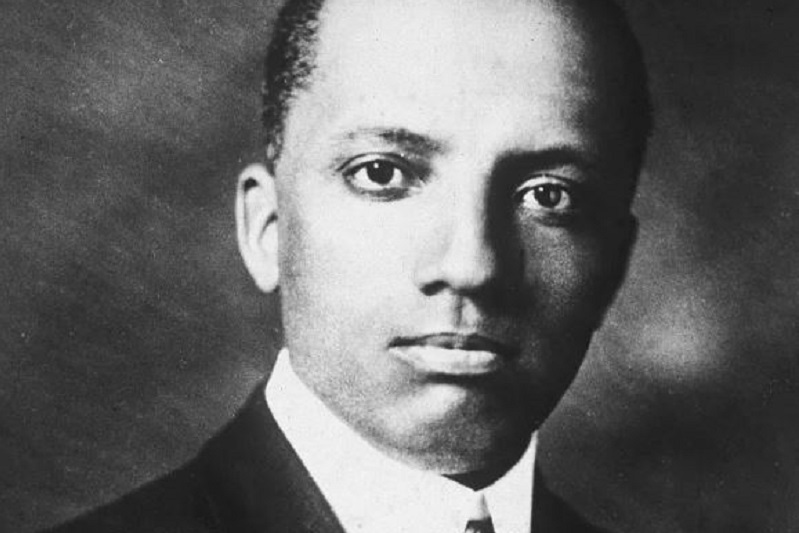University Libraries

Father of Black History
By Diane Osman and Erin McGraw '24
The University of Dayton Libraries celebrate Black History Month by recognizing Carter G. Woodson, often referred to as the father of Black history. Woodson was a prominent historian, scholar, educator and publisher who devoted his life's work to the acknowledgment and promotion of the predominantly overlooked achievements of Black Americans and people of African descent. He believed it was important for young African Americans to understand their history and be proud of their heritage.
“If a race has no history, if it has no worthwhile tradition, it becomes a negligible factor in the thought of the world, and it stands in danger of being exterminated,” Woodson wrote in The Mis-Education of the Negro, published in 1933.
Woodson was born in 1875 in West Virginia to former slaves. He spent most of his childhood working as a sharecropper or a miner to help support his large family. Woodson understood at an early age that education was important as he strived to make the most of his opportunity of freedom. Although he did not enter high school until the age of 20, he completed his diploma in less than two years. He became a teacher and a school principal before earning his bachelor's degree in literature from Berea College in Kentucky. In 1903, after attending Berea College, Woodson became a school supervisor in the Philippines for the U.S. government. He then acquired a master’s degree at the University of Chicago. In 1912, Woodson became the second African American (W.E.B. Du Bois being the first) to earn a doctorate from Harvard University. He became a faculty member at Howard University and eventually served as the dean of the College of Arts and Sciences.
According to Woodson’s biography on the website of the NAACP, after being barred from the American Historical Association (AHA) Conferences, even though he was a paying member, Woodson felt the AHA did not value or have any interest in Black history. He saw African American contributions “overlooked, ignored, and even suppressed by the writers of history textbooks and the teachers who use them.”
In 1915, while on a trip to Chicago to join a national celebration of the 50th anniversary of emancipation, he joined thousands of other Black Americans in an exhibit highlighting African American achievements. Inspired by the history and heritage, Woodson realized that for Black scholars to study and preserve Black history, he would have to create a separate institutional structure. With funding from several foundations, Woodson founded the Association for the Study of Negro Life and History, now called the Association for the Study of African American Life and History. He described the mission as the scientific study of “neglected aspects of Negro life and history.” In 1916, Woodson founded the Journal of Negro History, now called the Journal of African American History, which is still published today. In 1937, the ASNLH published the Negro History Bulletin. Woodson’s efforts put Black Americans into U.S. history.
In 1926, Woodson worked to establish a Negro History Week and announced its launch in February of that year. He chose February because of the birthdays of two prominent figures in the fight to abolish slavery — Abraham Lincoln and Frederick Douglass. Held in the second week of February, it encouraged nationwide celebrations planned by local schools, governments and communities. “The Man Behind Black History Month,” an article about Woodson on the website history.com, says that in the decades that followed, African Americans on college campuses became more aware of the extent of their historic experience. Younger members of the ASNLH urged the organization to incorporate a shift to a monthlong celebration of African American history.
In 1976, President Gerald Ford proclaimed February as a national celebration of Black history, stating, “We can seize the opportunity to honor the too-often neglected accomplishments of Black Americans in every area of endeavor through our history.” Since that time, each president has issued a proclamation declaring February Black History Month and designated a specific theme. The theme for 2023 is Black Resistance, exploring how “African Americans have resisted historic and ongoing oppression, in all forms since the nation’s earliest days.”
Library Resources
The University Libraries has many resources available to study the history of African Americans and their achievements.
Literature Written by Carter Woodson
- A Century of Negro Migration (1918, online resource) traces the migration of southern Blacks north and the west from the colonial era through the early 20th century. Documented with information from contemporary newspapers, personal letters and academic journals, the book is both a discerning study and a vivid account of decades of harassment and humiliation, hope and achievement. (Amazon review)
- The Negro in Our History (1922) presents a succinct account of the influence of Black Americans on United States history. (Amazon review)
- The Mis-Education of the Negro (1933) posits that Blacks of Woodson’s day were being culturally indoctrinated, rather than taught, in American schools, causing Blacks to become dependent and to seek out inferior roles. (Amazon review)
Books by Other Authors on Race and Justice
- Better, Not Bitter: Living on Purpose in the Pursuit of Racial Justice, by Yusef Salaam
- The Fire This Time: A New Generation Speaks About Race, edited by Jesmyn Ward
- Black Joy: Stories of Resistance, Resilience, and Restoration, by Tracey Michae’l Lewis-Giggets
Online Resources (UD login required)
- African American Newspapers
- Oxford African American Studies Center
- The Journal of African American History
Recommended Reading
The University Libraries have a research guide on Black History Month with additional resources.
Resources used for this article:
- https://www.history.com/news/the-man-behind-black-history-month
- https://naacp.org/find-resources/history-explained/civil-rights-leaders/carter-g-woodson
- https://asalh.org/
- https://www.history.com/topics/black-history/black-history-month
- https://www.biography.com/scholar/carter-g-woodson
— Diane Osman is a member of the University Libraries diversity and inclusion team. Erin McGraw is a biology and theology double major.
